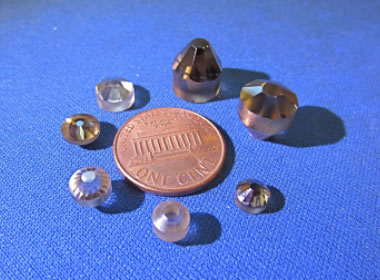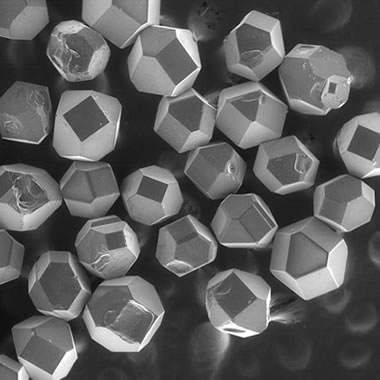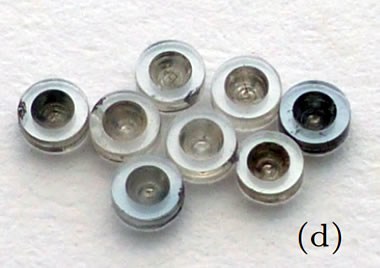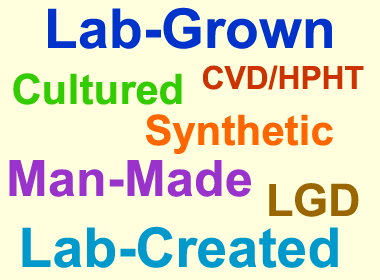 |
| Diamond Anvils manufactured from synthetic diamond are used in high-pressure testing and experiments. These anvils were manufactured from CVD diamond. Their bases measure between 5 and 10 millimeters in diameter and their culets between 1.5 and 3 millimeters. |
Lab-Grown Diamonds
Also known as lab-created diamonds, man-made diamonds, synthetic diamonds
 |
Synthetic Diamonds grown in the High-Temperature Materials Laboratory
of the Moscow Steel and Alloys Institute. |
Lab-grown diamonds are diamonds that have been made by people.
Just like the natural diamonds that form deep within the Earth, lab-grown diamonds are a crystalline form of carbon with a cubic (isometric) crystal structure.
Lab-grown diamonds have chemical, physical, and gemological properties that are the same as natural diamonds.
However, the manufacturing processes used to produce lab-grown diamonds give them subtle features that trained gemologists and specialized instruments can use to separate lab-grown diamonds from natural diamonds.
An ability to distinguish natural diamonds from lab-grown diamonds is very important.
In the gem and jewelry industry, many people have a strong preference for natural diamonds. They prefer them because they are made by nature and also because of their rarity.
As a result, natural diamonds sell for a higher price than lab-grown diamonds. However, many people will gladly buy a lab-grown diamond because they can be purchased at a significant cost savings.
A Brief History of Lab-Grown Diamonds
Lab-grown diamonds have been produced since the 1950s. Nearly all of the earliest lab-grown diamonds were put to industrial uses such as making abrasive granules for cutting, drilling, and polishing tools.
One of the main incentives for developing methods of producing man-made diamonds was the fact that abrasive tool industries were starting to consume more diamond than could easily be supplied by mining.
The young diamond-growing industry had the potential to produce an unlimited and reliable supply of diamond abrasives if the cost of production was contained.
This challenge was quickly achieved. Today diamond abrasive granules are produced in hundreds of factories in many parts of the world at a cost of under $1 per carat.
Within a few decades, lab-grown diamonds were being made pure enough and large enough that they could be used in a variety of high-tech applications.
Lab-grown diamonds were being used as heat sinks in advanced computers; wear-resistant coatings on tools and bearings; high-durability windows; tiny anvils for high pressure experiments; specialized lenses; speaker domes; and much more.
During the 1990s a small number of gem-quality diamonds were being produced in laboratories, but very few entered the marketplace.
These diamonds were costly to produce, and manufacturers needed to reduce costs and improve quality to be competitive in the diamond jewelry market.
By 2010, the quality of lab-grown diamonds had improved significantly. A small but increasing number of lab-grown diamonds began entering the gem and jewelry market.
Today, several companies are creating commercial quantities of beautiful lab-grown diamonds with spectacular clarity and color.
Now, several percent of the diamonds entering the gem and jewelry marketplace are laboratory-grown.
Separating Natural and Lab-Grown from Imitation
An ability to positively identify natural diamonds, lab-grown diamonds, and the many imitation materials is essential today for several reasons.
First, significant price differences exist between these materials.
Second, diamond customers are cautious and want to know exactly what they are buying.
And, third, the reputation of every business that sells diamonds is at risk.
Diamond merchants who do not monitor and confirm the identity of inventory coming into their business expose themselves to the risk of financial loss, civil liability and a loss of reputation.
Misidentified merchandise and fraud can enter the supply chain at any level.
Fortunately, both lab-grown and natural diamonds are distinctly different from the many diamond imitations such as cubic zirconia and synthetic moissanite.
These imitations differ from lab-grown diamonds and natural diamonds in many ways. They have a completely different chemical composition and a variety of different physical properties.
Competent gemologists can easily recognize the imitations.
Most jewelry professionals, with training and practice, can separate imitations from natural and synthetic diamonds with a simple testing device that can be purchased for less than $200.
Differences Between Lab-Grown and Natural
Contrary to some marketing messages, lab-grown diamonds and natural diamonds are not identical in every way.
Lab-grown diamonds are produced at Earth’s surface by two different processes: HPHT (high pressure high temperature) and CVD (chemical vapor deposition).
Diamond crystals grown in these manufacturing processes inherit characteristics of the manufacturing process that can be used to tell them apart. These characteristics can also be used to separate them from natural diamonds.
Some lab-grown diamonds can be separated from natural diamonds by a trained gemologist using standard tools.
Using a gemological microscope, the gemologist can sometimes identify inclusions or other features that are unique to HPHT-grown diamonds, CVD diamonds or natural diamonds.
Using a microscope that enables observations using ultraviolet light can reveal growth patterns unique to these different types of diamonds, but most gemologists do not have this equipment.
Even if the gemologist had that equipment, and the necessary training, many diamonds would not be identified with certainty. Thus, more sophisticated tools are needed.
Fortunately, several companies have invented portable screening devices that can separate natural diamonds from lab-grown diamonds.
These devices correctly identify about 98% of natural diamonds and refer all other stones (lab-created diamonds, imitation materials, and the remaining 2% of natural diamonds) for additional testing.
The cost of these screening devices starts at about $4000.
More sophisticated devices that successfully separate natural, lab-grown, and imitation stones from one another can be purchased, but the cost for these starts at about $20,000, which is quite costly for many small businesses.
To buy and sell with safety and confidence, a business must invest in the knowledge of its staff and obtain the necessary equipment.
Appropriate Names for Diamonds
A wide variety of names have been used for diamonds that have been made by people.
In the early days, the names "synthetic diamonds" and "man-made diamonds" were most often used.
Synthetic diamonds was the more scientific name and the name used among technical people. Man-made diamonds was a name used by the general public.
Up until recently the name "lab created" was used much more often than "lab grown".
In December of 2013 the number of people using the name "lab created diamonds" as a Google search query was rivaling the use of "man made diamonds", which was the dominant search query for these materials at that time.
In February of 2017 "lab created diamonds" became the clearly dominant query. (You can see this history for yourself in the graphic above.)
Then a major shift hit the language of Google search queries. In June of 2018, "lab grown diamonds" shot up to the leading position.
This date is coincident with the first appearance of heavy online advertising for the Lightbox diamond brand of De Beers.
Their ads and their website clearly used the name "lab-grown diamonds." Their product launch most likely changed the language being used by people searching Google.
It also caused a major increase in the number of people who queried Google for information about diamonds made by people.
Hobart M. King is the owner and publisher of Geology.com. He is a geologist with over 40 years of experience, has a Ph.D. in geology, and is a GIA graduate gemologist. Much of his work has focused on coal geology, industrial minerals, gemology, geologic hazards, and geoscience education.
He has authored many of the internet’s most popular articles about rocks, minerals and gems. He writes most of the content published on Geology.com and compiles its daily news. His writing is read by over a million people each month, making him one of the world’s most widely read geologists.
Hobart M. King, Ph.D., GIA GG
Dr. King earned a Ph.D. and an M.S. in geology from West Virginia University; a B.S. in geology from California University of Pennsylvania; and, a Graduate Gemologist Diploma from the Gemological Institute of America. He is a registered professional geologist in the Commonwealth of Pennsylvania.
He has worked as a geologist in a variety of settings since 1975.
https://geology.com/diamond/lab-grown-diamonds/
 |
Diamond Lenses: A photograph of concave parabolic diamond x-ray lenses. Diamond lenses for focusing x-ray beams have been in use since the late 1990s. The lenses in this photo are about 1 millimeter across.
|


No comments:
Post a Comment